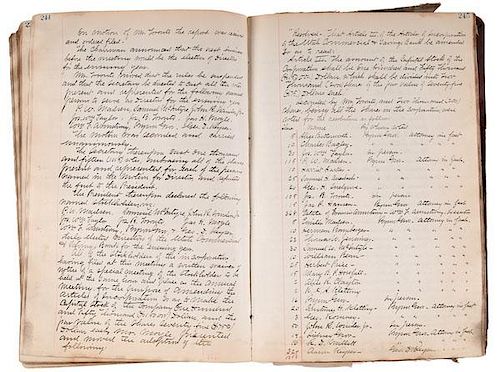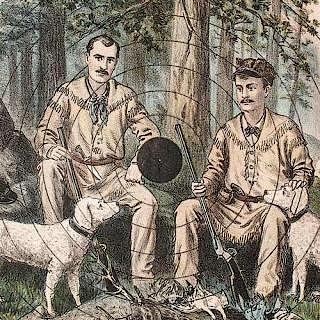Utah Commercial & Savings Bank, Incorporation Log, 1889-1912
About Seller
6270 Este Ave.
Cincinnati , OH 45232
United States
With offices in Cincinnati, Cleveland and Denver, Cowan’s holds over 40 auctions each year, with annual sales exceeding $16M. We reach buyers around the globe, and take pride in our reputation for integrity, customer service and great results. A full-service house, Cowan’s Auctions specializes in Am...Read more
Two ways to bid:
- Leave a max absentee bid and the platform will bid on your behalf up to your maximum bid during the live auction.
- Bid live during the auction and your bids will be submitted real-time to the auctioneer.
Bid Increments
| Price | Bid Increment |
|---|---|
| $0 | $25 |
| $500 | $50 |
| $1,000 | $100 |
| $2,000 | $250 |
| $5,000 | $500 |
| $10,000 | $1,000 |
| $20,000 | $2,500 |
| $50,000 | $5,000 |
| $100,000 | $10,000 |
About Auction
Nov 20, 2015 - Nov 21, 2015
Cowan's Auctions dawnie@cowans.com
- Lot Description
Utah Commercial & Savings Bank, Incorporation Log, 1889-1912
381pp, most manuscript. Starting date May 20, 1889 to 1912. 16.25 x 10.25 in. Also contains loose ledger sheets, Expense Acct. 1902-1912 mixed.
The first entry is Salt Lake City, May 20, 1889. Meeting at P.W. Madsens Furniture Store. The names of 31 men present follows. They agreed to issue a notice, according to the notes from the first meeting: Notice (published May 25/89 Herald & Tribune) There will be a meeting of the subscribers to the Utah Commercial and Savings Bank held at P.W. Madsens Furniture Store on Wednesday, May 29th 1899 at 7:30 P.M. to adopt Articles of Association and perfect its organization. J.T. Little, Treasurer.
The next page contains notes from the May 29th meeting, and the Articles of Incorporation which begins: In pursuance of an act passed by the Legislation Assembly of the Territory of Utah, and approved March 8th 1888, entitled "An Act Providing for Banking,..." Later: The amount of capital stock of this corporation shall be Two Hundred Thousand Dollars ($200,000) and the number of shares into which the same shall be divided are Two Thousand (2000) shares of One Hundred Dollars ($100). After the Articles is a list of 71 shareholders, the city of residence of each (all residents of SLC except last five, and all but one of them is still a resident of Utah), and the number of shares each is purchasing.
Francis Armstrong (elected President), Dr. Wm. Groves, M.E. Cummings (elected Cashier) and P.W. Madsen (elected Vice President) each had 100 shares. Charles E. Pomeroy was elected Asst. Cashier, and there were five other Directors (board members). The By Laws were approved June 3, 1889 and are entered in the ledger.
The pages that follow contain summaries of Director's and shareholders' meetings, plus annual financial summaries. Later, these statements are filled in on partially printed forms and tipped in on the appropriate page up to early 1912.
According to the chapter on "Banking and Finance" by Leonard J. Arrington in the History of Utah, as the population grew, 34 banks were established between 1864-1880, most of them private (extensions of other operations such as freighting). The next two decades saw 50 more banks established. The years after 1880 thus mark Utah’s financial coming-of-age, just as the years before 1880 ushered in the beginnings of a monetary economy. In a real sense, the expansion transformed Utah’s economy from a frontier cooperative society into the more highly articulated, specialized, and interdependent agricultural-industrial society of the twentieth century.(http://www.uen.org/utah_history_encyclopedia/b/BANKING.html, accessed 10.19.2015)
On page 377, April 10, 1912, there is a two-page resolution tipped in to sell and transfer assets of the bank to the State Bank of Utah (Zion's Saving Bank & Trust Company crossed out throughout the document). Last paragraph: Be it further resolved: That this corporation be dissolved in accordance with law and the President and Board of Directors of this corporation are hereby authorized and directed to take all proper and necessary steps for the purpose of effectuating the dissolution of this corporation. There follow several letters between the State Bank of Utah and the Utah Commercial Bank regarding the transfer of assets.
The William Francis Armstrong papers are in the Utah State Historical Society, Salt Lake City. According to the biographical introduction to the collection: Francis Armstrong (1839-1899) was born in England, his family emigrating to Canada when he was 11. At either 16 or 18 years of age (sources differ) he emigrated to the United States, finding work in Richmond, Missouri. Many of Richmond's residents belonged to a splinter group of Mormons, so Armstrong would have understood their views and practices. When Missouri was torn apart in the Civil War, Francis moved to SLC, and officially became a Mormon shortly after his arrival. He had worked in flour and lumber mills in Missouri, and found work in Brigham Young's flour mill, then Feramorz Little's lumber mill in Utah. He saved enough to buy the latter business, purchased a few more pieces of land, and was in business for himself by 1868.
In 1864, he married Isabella Siddoway, his only wife, and reportedly a force in her own right. Because he was monogamous, he was able to bridge the Mormon and non-Mormon worlds and help his (polygamous) brethren who were being hunted down and incarcerated by the government. Armstrong also took control of LDS church assets and businesses before they could be seized by the government, moderating the effect of the government attack on the LDS church.
Armstrong was also elected to several public positions, including school board, city council, selectman for the court, and Mayor of Salt Lake City. As Mayor, he also worked with non-Mormons to build a secular Chamber of Commerce and other alliances that strengthened the economic communities in Utah. He founded the Utah Commercial & Savings Bank, and served as its President until his death.
In 1888 he commissioned Richard Karl August Kletting to design the Utah Commercial & Savings Bank building at 22 East 100 South. The building today is described as "Richardsonian Romanesque," and is on the National Register of Historic Places.
Francis Armstrong was succeeded by his son, William Francis Armstrong (1871-1940). The younger Armstrong was not involved in the public affairs of his father. He also had a more secular viewpoint than his father's pioneering generation. According to the USHS biography: "Administering his family's property holdings and directing the activities of the bank occupied most of William's middle years. The bank seems to have over-extended itself and it ran into difficulty with the bank examiner in 1905 and later with the Utah Secretary of State. The dialogue between the two ran on for several years and led to the liquidation of the bank in 1918." He spent most of the remainder of his life running the Standard Furniture Company, which he organized in 1908.Spine missing (several pieces with book). Front board off but present. Boards badly warped (water?) Several "breaks" in the text block, but all pages appear to be present. Overall condition is a bit rough, but all pages present and readable.Condition
- Shipping Info
-
SHIPPING. At the request of the buyer, Cowan's will authorize the shipment of purchased items. Shipments usually occur within two weeks after payment has been received. Shipment is generally made via UPS Ground service. Unless buyer gives special instructions, the shipping method shall be at the sole discretion of Cowan's Auctions, Inc.. Cowan's is in no way responsible for the acts or omissions of independent handlers, packers or shippers of purchased items or for any loss, damage or delay from the packing or shipping of any property.
-
- Buyer's Premium



 EUR
EUR CAD
CAD AUD
AUD GBP
GBP MXN
MXN HKD
HKD CNY
CNY MYR
MYR SEK
SEK SGD
SGD CHF
CHF THB
THB















